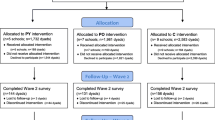Abstract
Objectives A number of psychosocial factors have been identified as mediators of the impact that acculturation exerts on adolescent drug use. We sought to evaluate gender differences in mediators of the impact of acculturation on substance abuse. Methods We used t-test and logistic regression to analyze data collected from 8,200 adolescent students who self-identified as Hispanic during the 2004 Florida Youth Substance Abuse. The dependent variable was past 30 day use of marijuana and the key independent variable was language spoken at home. The covariates were 32 risk and protective (R/P) factors for drug use as defined by the Social Development Strategy framework. Results For boys, the ORs associated with language changed significantly with the addition of any of the R/P factors to their basic model, while for girls only the addition of the Individual domain factors significantly changed the ORs. Discussion and conclusion These findings suggest that among boys the interventions that target any or all of the R/P factors may be able to positively alter the drug using behaviors among boys. In contrast, only the interventions that reinforce girls’ innate strengths may succeed in dissuading them from initiating and perpetuating drug use. This information can be used to develop policies and interventions geared toward preventing drug problems among the growing group of adolescent of immigrant descent.

Similar content being viewed by others
References
Horgan C, Skwara KC, Strickler G, Anderson L. Substance abuse: the nation’s Number One health problem, key indicators for policy, Update 2001. Schneider Institute for Health Policy, Brandeis University. Downloaded on 08-26-05.
Healthy People 2010 Summary of Objectives. U.S. Department of Health and Human Services Centers for Disease Control and Prevention.
National Institute on drug abuse, teen drug abuse: high school and youth trends, 2000 Monitoring the Future Study, November 2001.
Wright D, Pemberton M. Risk and protective factors for adolescent drug use: findings from the 1999 National Household Survey on drug abuse (DHHS Publication No. SMA 04-3874, Analytic Series A-19). Rockville, MD: Substance Abuse and Mental Health Services Administration, Office of Applied Studies; 2004.
Catalano RF, Hawkins JD. The social development model: a theory of antisocial behavior. In: Hawkins JD, editor. Delinquency and crime: current theories. New York: Cambridge University Press; 1996. p. 149–97.
Hawkins JD, Catalano RF, Miller JY. Risk and protective factors for alcohol and other drug problems in adolescence and early adulthood: implications for substance abuse prevention. Psychol Bull. 1992;112:64–105. doi:10.1037/0033-2909.112.1.64.
National Institute on Drug Abuse. Drug use among racial/ethnic minorities, Revised September 2003. NIH Publication No. 03-3888. U.S. Department of Health and Human Services National Institutes of Health National Institute on Drug Abuse, Division of Epidemiology, Services, and Prevention Research.
Day JC. National Populations Projections. US Census Bureau, Population Division and Household Economic Statistics Division, 2001. Available at http://www.census.gov/population/www/pop-profile/natproj.html. Downloaded on 05/15/05.
De La Rosa MR, Adrados JR, Milburn N. Drug abuse among minority youth: advances in research and methodology. NIDA Research Monograph. U.S. Department of Health and Human Services National Institute of Health; 1993.
McQueen A, Getz JG, Bray JH. Acculturation, substance use, and deviant behavior: examining separation and family conflict as mediators. Child Dev. 2003;74(6):1737–1750. doi:10.1046/j.1467-8624.2003.00635.x.
Vega WA, Gil AG, Zimmermann RS. Patterns of drug use among Cuban-Americans, African-Americans, and white non-Hispanic boys. Am J Public Health. 1993;83:257–9.
Blake S, Ledsky R, Goodenow C, O’Donnell L. Recency of immigration, substance abuse, and sexual behaviors among Massachusetts adolescents. Am J Public Health. 2001;91:794–8.
Amodeo M, Jones LK. Using the AOD cultural framework to view alcohol and drug issues through various cultural lenses. J Soc Work Educ. 1998;34(3):384–99.
Marsiglia FF, Kulis S, Hecht ML. Ethnic labels and ethnic identity as predictors of drug use among middle school students in the Southwest. J Res Adolesc. 2001;11(1):21–48. doi:10.1111/1532-7795.00002.
Berry JW, Kim U. Acculturation and mental health. In: Dasen P, Berry JW, Sartorius N, editors. Health and cross-cultural psychology: towards application. London: Sage Publication; 1988. p. 207–36.
Oetting ER, Beauvais F. Peer cluster theory: drugs and the adolescent. J Couns Dev. 1986;65(1):17–30.
Szapocznic J, Kurtines W. Acculturation, biculturism, and adjustment among Cuban Americans. In: Padilla AM, editor. Acculturation: theory, models, and some findings. Boulder, CO: Westview Press; 1980. p. 139–59.
National Institute on Drug Abuse. Gender differences in drug abuse risks and treatment. Nida Notes 2005;15(4).
Holdcraft LC, Iacono WG. Cross-generational effects on gender differences in psuchiatric drug abuse and dependence. Drug Alcohol Depend. 2004;74(74):147–58. doi:10.1016/j.drugalcdep.2003.11.016.
Kauffman S, Silver P, Poulin J. Gender differences in attitudes toward alcohol, tobacco, and other drugs. Soc Work. 1997;42(3):231–241.
CASA. The formative years: pathways to substance abuse among girls and young women ages 8–22. 2003b
Florida Department of Children and Families 2000, Florida Youth Substance Abuse Survey State Report, 2000. Available at: http://www5.myflorida.com/cf_web/myflorida2/healthhuman/substanceabusementalhealth/publications/fysas/flrpt.pdf. Downloaded on 07/12/05.
Guthrie BJ, Low LK. A substance use prevention framework: considering the social context for African American girls. Public Health Nurs. 2000;17(5):363–73. doi:10.1046/j.1525-1446.2000.00363.x. (Boston, Mass).
Spira M, Grossman S, Wolff-Bensdorf J. Voice and identity in a bicultural/bilingual environment. Child Adolesc Soc Work J. 2002;19(2):115–39. doi:10.1023/A:1014546406558.
Friedman AS. High school drug abuse clients. In: Treatment research notes. Division of Clinical Research, National Institute on Drug Abuse. Rockville, MD; 1983.
Author information
Authors and Affiliations
Corresponding author
Rights and permissions
About this article
Cite this article
Saint-Jean, G. Gender Differences in the Salience of Psychosocial Mediators of the Impact of Acculturation on Substance Abuse among Hispanic Youth in Florida. J Immigrant Minority Health 12, 166–172 (2010). https://doi.org/10.1007/s10903-008-9196-5
Received:
Accepted:
Published:
Issue Date:
DOI: https://doi.org/10.1007/s10903-008-9196-5




